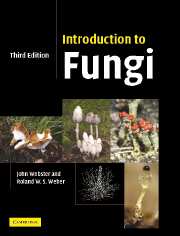Book contents
- Frontmatter
- Contents
- Preface to the first edition
- Preface to the second edition
- Preface to the third edition
- Acknowledgements
- 1 Introduction
- 2 Protozoa: Myxomycota (slime moulds)
- 3 Protozoa: Plasmodiophoromycota
- 4 Straminipila: minor fungal phyla
- 5 Straminipila: Oomycota
- 6 Chytridiomycota
- 7 Zygomycota
- 8 Ascomycota (ascomycetes)
- 9 Archiascomycetes
- 10 Hemiascomycetes
- 11 Plectomycetes
- 12 Hymenoascomycetes: Pyrenomycetes
- 13 Hymenoascomycetes: Erysiphales
- 14 Hymenoascomycetes: Pezizales (operculate discomycetes)
- 15 Hymenoascomycetes: Helotiales (inoperculate discomycetes)
- 16 Lichenized fungi (chiefly Hymenoascomycetes: Lecanorales)
- 17 Loculoascomycetes
- 18 Basidiomycota
- 19 Homobasidiomycetes
- 20 Homobasidiomycetes: gasteromycetes
- 21 Heterobasidiomycetes
- 22 Urediniomycetes: Uredinales (rust fungi)
- 23 Ustilaginomycetes: smut fungi and their allies
- 24 Basidiomycete yeasts
- 25 Anamorphic fungi (nematophagous and aquatic forms)
- References
- Index
- Plate section
9 - Archiascomycetes
- Frontmatter
- Contents
- Preface to the first edition
- Preface to the second edition
- Preface to the third edition
- Acknowledgements
- 1 Introduction
- 2 Protozoa: Myxomycota (slime moulds)
- 3 Protozoa: Plasmodiophoromycota
- 4 Straminipila: minor fungal phyla
- 5 Straminipila: Oomycota
- 6 Chytridiomycota
- 7 Zygomycota
- 8 Ascomycota (ascomycetes)
- 9 Archiascomycetes
- 10 Hemiascomycetes
- 11 Plectomycetes
- 12 Hymenoascomycetes: Pyrenomycetes
- 13 Hymenoascomycetes: Erysiphales
- 14 Hymenoascomycetes: Pezizales (operculate discomycetes)
- 15 Hymenoascomycetes: Helotiales (inoperculate discomycetes)
- 16 Lichenized fungi (chiefly Hymenoascomycetes: Lecanorales)
- 17 Loculoascomycetes
- 18 Basidiomycota
- 19 Homobasidiomycetes
- 20 Homobasidiomycetes: gasteromycetes
- 21 Heterobasidiomycetes
- 22 Urediniomycetes: Uredinales (rust fungi)
- 23 Ustilaginomycetes: smut fungi and their allies
- 24 Basidiomycete yeasts
- 25 Anamorphic fungi (nematophagous and aquatic forms)
- References
- Index
- Plate section
Summary
Introduction
Several independent phylogenetic analyses of DNA sequence data (e.g. Berbee & Taylor, 1993; Sjamsuridzal et al., 1997; Liu & Hall, 2004) have grouped together a range of seemingly very diverse genera of ascomycetes. This group is considered to be the oldest of three broad evolutionary lineages of Ascomycota and has thus been named Archiascomycetes (Nishida & Sugiyama, 1994). The core of the Archiascomycetes consists of the genera Taphrina and Protomyces, which are facultative biotrophic plant pathogens, and the saprotrophic fission yeast Schizosaccharomyces. Also now included are the yeast-like Pneumocystis, which causes pneumonia in immunocompromised patients (see p. 259); the filamentous fungus Neolecta, which parasitizes the roots of higher plants (Redhead, 1977; Landvik et al., 2003); and the anamorphic yeast Saitoella. Yet other genera are included as possible members because even though their appropriate DNA sequences have not yet been obtained, they are known to be related to confirmed members. In total, the class Archiascomycetes currently contains some 150 species in 10 genera.
Because of their diverse morphological appearances and modes of life, it is difficult to describe common characters typical of the Archiascomycetes. With the exception of Neolecta, which produces apothecia, ascocarps are lacking and asci are produced individually by yeast cells or by conversion of hyphal tips. There are no differentiated ascogenous hyphae. Asexual reproduction is usually by simple division of vegetative yeast cells by budding or fission.
- Type
- Chapter
- Information
- Introduction to Fungi , pp. 250 - 260Publisher: Cambridge University PressPrint publication year: 2007



